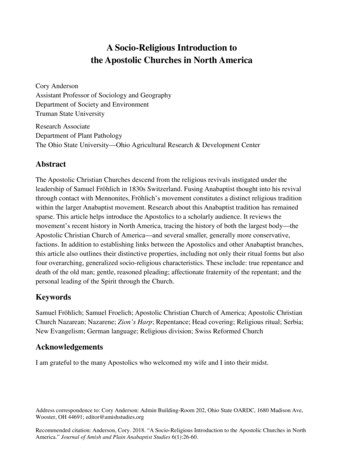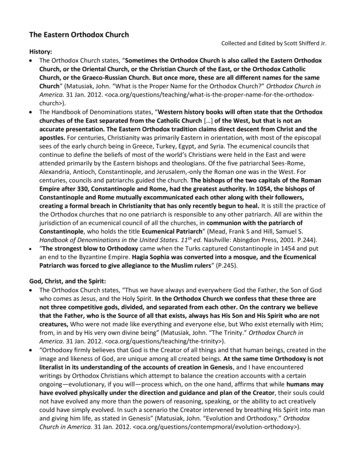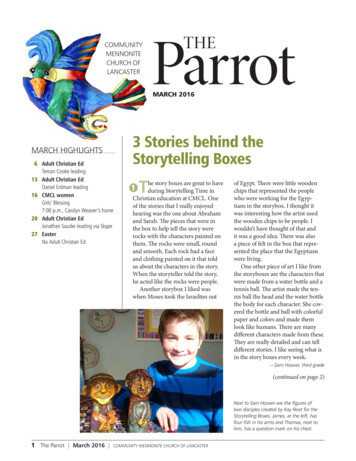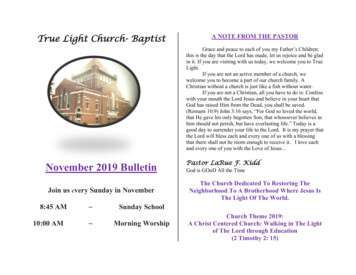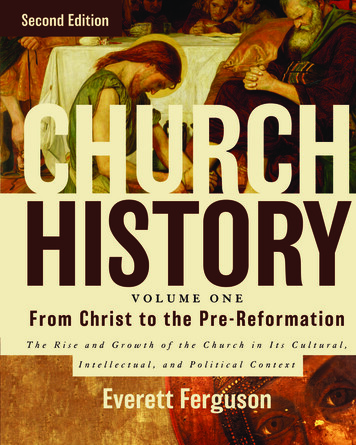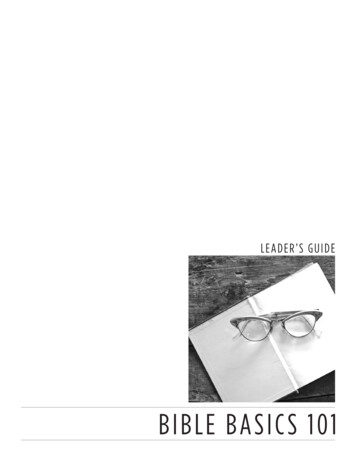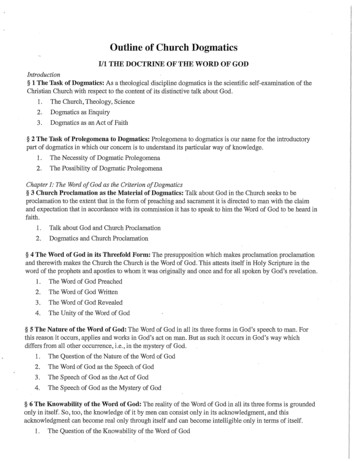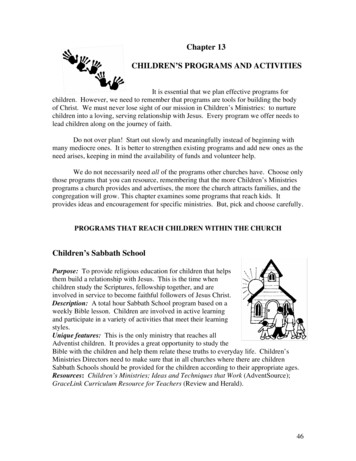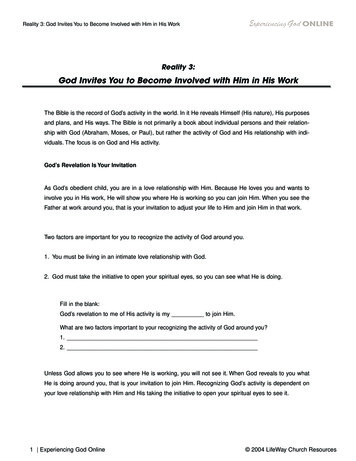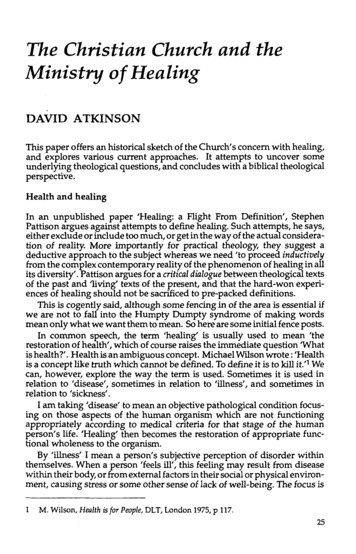
Transcription
The Christian Church and theMinistry of HealingDAVID ATKINSONThis paper offers an historical sketch of the Church's concern with healing,and explores various current approaches. It attempts to uncover someunderlying theological questions, and concludes with a biblical theologicalperspective.Health and healingIn an unpublished paper 'Healing: a Flight From Definition', StephenPattison argues against attempts to define healing. Such attempts, he says,either exclude or include too much, or get in the way of the actual consideration of reality. More importantly for practical theology, they suggest adeductive approach to the subject whereas we need 'to proceed inductivelyfrom the complex contemporary reality of the phenomenon of healing in allits diversity'. Pattison argues for a critical dialogue between theological textsof the past and 'living' texts of the present, and that the hard-won experiences of healing should not be sacrificed to pre-packed definitions.This is cogently said, although some fencing in of the area is essential ifwe are not to fall into the Humpty Dumpty syndrome of making wordsmean only what we want them to mean. So here are some initial fence posts.In common speech, the term 'healing' is usually used to mean 'therestoration of health', which of course raises the immediate question 'Whatis health?'. Health is an ambiguous concept. Michael Wilson wrote: 'Healthis a concept like truth which cannot be defined. To define it is to kill it.' 1 Wecan, however, explore the way the term is used. Sometimes it is used inrelation to 'disease', sometimes in relation to 'illness', and sometimes inrelation to 'sickness'.I am taking 'disease' to mean an objective pathological condition focusing on those aspects of the human organism which are not functioningappropriately according to medical criteria for that stage of the humanperson's life. 'Healing' then becomes the restoration of appropriate functional wholeness to the organism.By 'illness' I mean a person's subjective perception of disorder withinthemselves. When a person 'feels ill', this feeling may result fromdiseasewithin their body, or from external factors in their social or physical environment, causing stress or some other sense of lack of well-being. The focus isM. Wilson, Health is for People, DLT, London 1975, p 117.25
Anvil Vol. 10, No. 1, 1993on the whole person. 'Healing' then becomes the restoration of a person's·sense of their own well-being.By 'sickness' can be meant a socially defined deviation from what issocially acceptable, or tolerable. A person is 'sick' in this sense if they cannotfunction according to society's standards. This may, for example, be becauseof their sexual orientation, the shape of their nose, teeth or breasts, somemental or physical handicap, or even the processes of ageing. (The questionsometimes has to be asked: who is sick here, the individual or the society?)'Healing' from sickness would then involve, for example, a change in sexualorientation, the straightening of the teeth, the removal of the handicap, or anattempt to delay the processes of ageing.It is important also to recognise that all healing takes place in a socialcontext. The diseased, ill or sick person is part of a network of relationships,and has a specific life history. Not only 'cure', but also issues of public health,preventative medicine, diagnosis, community and family care, post-treatment rehabilitation, and long term support, may well all be part of thehealing process. The determinants of health are both inherited and environmental. The handling of disease and of illness involves individual lifestyles,personal environments (physical, biological, social and political), and theavailability and allocation of resources in the promotion of good health andthe prevention of and response to disease.Thus 'healing' is a broad term, with fuzzy edges. Its range of meaningsincludes the restoration of bodily, emotional or mental functioning appropriate to a person's age, the restoration of a subjective sense of well-being ina person, the enabling of a person to handle their relationships constructively and to fit in acceptably to their society, and the historical, social,physical and political environments in which these processes can occur.This broad perspective is consistent with that of the Old Testament, inwhich health is best understood in relation to the word often translated'peace', shalom. When the Lord gives shalom, there is prosperity, a wholesome relationship with God, conciliation between people, physical, relational and social well-being. In this sense, Yahweh is 'the LORD who heals'. 2In the New Testament, the new age of the Kingdom of God is proclaimed inthe gospel of Jesus Christ who is the bringer of shalom. Much of the gospelnarrative is taken up with the healing ministry of Jesus which is part of hisproclamation of the Kingdom of God.3 We will need to explore this furtherin due course. 4Christian approaches to healing: an historical sketchMinistry to the diseased, the ill and the sick, has been part of Christianministry from the very start of the Christian Church. In the post-PentecostChurch, the apostles did many signs and wonders among the people (the'signs of a true apostle', 2 Cor. 12:12; cf. Rom. 15:19), and the sick and those2 Exod. 15:26.3 Matt. 4:23.4 D. Atkinson, 'Towards a Theology of Health' in Health, the Strength to be Human, IVP,Leicester, forthcoming.26
DAVID ATKINSON The Christian Church and the Ministry of Healingafilicted with unclean spirits were healed (cf. Acts 2:43; 3:6 ; 5:12-16; 6:8; 8:6;8:13; 14:3; 15:12; 19:11; 28:9).Christians are said to minister to Christ himself by 'visiting those who areill' (Matt. 25:39). Christians prayed for one another 'that you may be inhealth' (3 Jn. 2). There were recognisable 'giftsofhealings' in the early church(1 Cor. 12:9), and the practice of anointing with oil and prayer for ill peoplewho called for the elders is referred to in James 5:13 .Th re is very litte other reference to healing ministry in the Epistles.There are four particular references to people who are ill: Paul (2 Cor. 12:7);Timothy (1 Trm. 5:23); Epaphroditus (Phil. 2:27); Trophimus (2 Trm. 4:20).Inappropriate use of the Lord's Supper was seen by Paul as the cause of someillness in Corinth (1 Cor. 11:30). The book of Revelation looks forward to theday when 'God himself will be with them; he will wipe away every tear fromtheir eyes, and death shall be no more, neither shall there be mourning norcrying nor pain any more, for the former things have passed away' (Rev.21:30.During the first three centuries of the Church, as Evelyn Frost hasdocumented,s there is considerable evidence of a continuing charismatichealing ministry, and records of healing miracles. There is also (in Basil, forexample, who founded a hospital) evidence of close links between theChurch and the practice of medicine.Gradually, healing ministry became increasingly sacramental, combinedwith anointing and exorcisms. There is evidence of prayer for healing andanointing with oil in Tertullian, Origen, Jerome, Ambrose, Chrysostom,Augustine. After the fourth century a growing split between body and spiritin the understanding of human life became so emphasised that less valuewas placed on bodily health. Eventually anointing for healing was in manyways overshadowed by anointing for death, at least in the western Church.During the Middle Ages, with the growth of monastic orders, there is aphase of records of miraculous healings, often through contact with therelics of the saints. Despite caution from some Church leaders, at the level ofpopular devotion much of the healing ministry of the Church was associatedwith magic. 6 At this time also, the split between body and spirit led togrowing division between the Church and medical practice.Many Christians at the Reformation continued this split, attempting totake the magic out of religion. Many believed that illness was sent from God,and that suffering was to be endured patiently. Neither Luther nor Calvinbelieved in miraculous physical healings, but concentrated on the miracle ofthe spiritual healing of the soul through the grace of God. ArchbishopCranmer' s first Prayer Book o 1549 provided an Order for the Visitation of theSick, drawn from the Sarum Rite. It included a long exhortion reminding thesick person that sickness is 'God's Visitation' and that they should 'take ingood worthe the chastement of the Lord: for whom the Lord loueth hechastiseth'. It concluded with a form for anointing with oil, making the sign5 E. Frost, Christian Healing, aconsideration of the place ofspiritual healing in the church todayin the light of the doctrine and practice of the ante-Nicene church, London 1940.6 K. Thomas, Religion and the Decline of Magic, Weidenfield and Nicholson, London1971.27
Anvil Vol. 10, No. 1, 1993of the cross. The anointing was omitted in the second Prayer Book of 1552,presumably because of the Reformers' unease with such sacramental practice? The Council of Trent (1551) refused to recognise a rite of healing in theRoman Church, though it did promote the sacramental practice of extremeunction.Since the Reformation, the split between the Church and medical practice, fed by a dualistic view of human nature, has gone through variousphases. Through the influence of the Cartesian/Newtonian model, in whichnature was thought to work according to mechanical laws, there arose a newemphasis in the medical profession on the health of the body and on physicalhealing. This laid the foundation for the secular 'medical model' of healingwhich has had such an influence in the current century, although widelyquestioned in recent years. For Newton, God was deistically detached fromthe world of nature, so that any divine involvement in the healing processhad to be seen as part of the divine ordering of nature or as supernaturalintervention in the world of nature. Such an interventionist model wascriticised by philosophers of the Enlightenment such as Hume. There werecertain times (the revival of evangelical piety with the Wesley brothers, forexample), when miracles of healing were recorded. Pilgrimages have beenmade to Lourdes since visions of the Virgin Mary were claimed by fourteenyear old Bemadette Soubirous there in 1858, and healing properties claimedfor the stream of water Bemadette discovered. Catholic teaching aboutLourdes is very cautious,however, and the percentage of possible cures verylow.The medical missions of the nineteenth and early twentieth centuries tosome extent repaired the breach between the Church and medicine, and arenewed emphasis on the particular healing ministry of the Church wasstrengthened in the founding of guilds such as The Guild ofHealth (1904) andThe Guild of St. Raphael (1915). These re-established the healing ministry aspart of the sacramental life of the Church (though it was not until the 1960sthat the Roman Church recognised anointing with oil as a sacrament forhealing). The Church's Council for Health and Healing was formed underArchbishop Temple in 1944, and the Lambeth Conferences in 1908, 1920,1930 and 1958 illustrate the growing awareness within the Church ofEngland of the significance of the Church's healing ministry.The 1958 Report ofthe Archbishop's Commission on The Church's Ministryof Healing was a major Church of England survey recognising that doctorsand priests both minister in their different ways to the whole person. Itsuggested that healing should be understood as 'the enabling of a person tofunction as a whole in accordance with God's will for them'. It rejected theterms 'faith healing', 'spiritual healing', 'divine healing', preferring to speakof 'the Church's ministry of healing' as 'an integral part of the Church's totalwork by which men and women are to become true sons and daughters ofGod's Kingdom'. This ministry is of word, sacrament, pastoral care, and theuse of gifts - including medical gifts - which God has given.728Martin Bucer, for example, in Censura, speaks in decidedly hostile terms about thisparticular practice (E. C. Whitaker, Martin Bucer and The Book of Common Prayer,Alcuin Club/Mayhew McCrimmon, Great Wakering 1974, p 124ff).
DAVID ATKINSON The Christian Church and the Ministry of HealingThe Pentecostal churches, from their beginnings at the turn of the centuryin the Holiness movements and the Welsh revival of 1904, have alwaysincluded the ministry of 'divine healing' as part of their teaching. This cameto particular prominence in the great evangelistic campaigns of the 1920s(the Albert Hall was filled each Easter Monday from 1926 to 1939 for such anevent), in which divine healing was closely linked to evangelism. ThePente ostal doctrine that there is 'healing in the Atonement' (i.e. that Christbore our sicknesses as well as our sins on the cross) is central to this practice.It is worth questioning why it is that on the whole Pentecostal churches havegrown more quickly than other churches in areas of poverty and socialdeprivation.Some of the Pentecostal emphasis has been transposed into the mainlinechurches in a fresh way through the charismatic renewal movement of thepast 25 years. It has developed the emphasis on particular gifts of healing asone of the signs of the baptism of the Holy Spirit. The charismatic movement,through its ecumenical concerns, has also been instrumental in bringingtogether the charismatic and sacramental dimensions to the healing ministry.Until fairly recently, there has been less emphasis in the Christian churchon the community and political dimensions of healing and health care, thanon ministry to individuals. However, this imbalance is being counteracted.R. A. Lambourne, in Community, Church and Healing,s in 1963, studied someof the corporate and social aspects of the Church's ministry to the sick; PeterSelby's Liberating God (1983),9 sought to do the same for the world ofcounselling and spirituality; the Centre for Theology and Public Issues inNew College Edinburgh has produced some occasional Christian papers onhealth care issues in recent years, and a number of Christian ethicists havebeen writing on the social context of health and healing.1oAt the popular level, there is at present considerable interest in Christianhealing, though almost entirely concerned with individual illness, as aglance at the shelves of any Christian bookshop will illustrate.The current scene: a variety of approachesIt will become apparent that much of the current confusion concerning theministry of healing in the Church arises from differing theological convictions. Most Christians involved in the worlds of healing and medicine wishto link their practices to biblical theology, and especially to the significanceof the healing ministry of Jesus. However, how those links are made andwhat significance the earthly ministry of Jesus has for today's Church are atthe root of much current dispute.We will begin by trying to separate out the various strands in the currentconfusion. It is difficult to speak in general of 'models' of healing ministry,or even 'approaches' to healing ministry, for many involved in these minis8 RA. Lambourne, Community, Church and Healing, DLT, London 1963.9 P. Selby, Liberating God, SPCK, London 1983.10 S. E. Lammers and A. Verhey, eds, On Moral Medicine, Eerdmans, Grand Rapids 1987.29
Anvil Vol. 10, No. 1, 1993tries do not fit neatly into categories, and many would draw on insights froma variety of different sources. To identify the following strands in the fabricmay be helpful, however, and various writers are cited to illustrate each'strand' (though it would not be correct to identify each writer exclusivelywith that 'strand'). There seem to be at least the foliowing strands in currentChristian literature each of which we will outline in turn: Medical approaches Psychotherapy I pastoral counselling Inner Healing I prayer counselling Pentecostal healing I evangelism Charismatic I corporate ministry Deliverance ministry Holistic approaches Community care Public healthMedical approachesSome Christians, particularly within the medical profession, would endorsethe perspective of Peter Mayll that the restoration of the image of Godthrough the work of Christ is, in this world, spiritual and not physical, asdeath is inevitable. The priorities of gospel evangelism are concerned witheternal salvation, not temporary respite for ailing bodies. This is not to saythat partial healing through medical aid is not to oe sought, but that 'health'ultimately belongs to another world, and neither Scripture nor medicalexperience encourage us to believe in miraculous healing as normative forthe Church. Indeed, such a view detracts from the positive value of suffering, neurotically focuses on the outward, the visible and the temporal, andraises false expectations.Dr May denies that miraculous healings which closely resemble those ofChrist occur more than extremely rarely today, and argues that though Godcould give supernatural healing today, it is not part of his normal provision.There are echoes here of the stance of Reformed theology given classicexpression by B. B. Warfield in 1918,12 who argued that the special divinehealing gifts pr sent in the ministry of Christ and the apostles ceased withthe apostolic age. This is a view that many find very hard to sustain. Somewho do take this view tend to work with the sort of 'medical model' of thehuman person, based largely on the dualism of a NeWtonian world view,which understands the body as a machine, and illness as a failure in bodilyfunction, and in which mental and spiritual life and health are eitherunrelated to physical processes, or are understood to be reducible to physical processes.11 J. Goldingay, ed., Signs, Wonders and Healing, IVP, Leicester 1989.12 B. B. Warfield, Miracles, Yesterday and Today, Eerdmans, Grand Rapids 1918, (cf.discussion in C. Brown, That You May Believe, Eerdmans, Grand Rapids 1985).30
DAVID ATKINSON The Christian Church and the Ministry of HealingPsychotherapy I pastoral counsellingCounselling and psychotherapy in Christian settings seek to provide relational contexts in which people in pain can be helped to live more creativelyand more hopefully, by focusing on the emotional, relational, moral orcognitive aspects of their lives. Roger Hurding13 speaks of counselling assharing in the process by which 'we and those we try to help can movetowar9-s balance, maturity and a sense of identity, a sense of 'being me' inChrist. This can only be effected by the work of the Holy Spirit in our lives'.Laurence Crabb14 describes the goal of change for which counselling seeksin terms of 'health'. 'Healthy people' enjoy God, are liberated to be involvedwith others, know that they are as yet only on the way to maturity. Their liveshave a quiet power. They experience a 'marred joy', groaning as they wait foreternity. They are not afraid of confusion, they struggle, they fail, but theyhave a growing ability to be touched by God and to touch others, becomingfreer from paiitful memories and repressed emotions. Michael Jacobs saysthat 'Each new encounter in pastoral care provides a pastor with the chanceof helping people to develop and grow as whole persons. By 'wholeperson' I mean a man or woman as an individual as well as part of a familyand social unit. body, mind and spirit. with . psychological, ethical andtheological frames of reference.' 15Inner healing/ prayer counsellingCounselling merges into prayer for inner healing in books such as those byDavid Seamands.16 By 'inner healing' is meant the approach to counsellingwhich looks for an experience of the Holy Spirit to restore a person's healthin the deep areas of personal pain, by dealing with the root causes of hurt.Ruth Carter Stapleton uses a process of guided meditation, 'faith-imagination', in which Jesus Christ, the same yesterday, today and for ever, is invitedin prayer to go back into a person's past life to heal traumatic episodes. 17Building on the work of Agnes Sandford,18 Francis MacNutt writes: 'Thebasic idea of inner healing is that Jesus can take the memories of our past and(i) heal them from wounds that still remain and affect our present lives; and(ii) fill with his love all those places in us that have been empty for so long,once they have been healed and drained of the poison of past hurts andresentment. At times the healing is progressive and takes several sessions,but I believe that it is always God's desire to heal us of those psychologicalhurts that are unredemptive and that prevent us from living with the innerfreedom that belongs to the children of God.' 191314151617R Hurding Restoring the Image, Paternoster, Exeter 1980, p 12.L. J. Crabb, Understanding People, Marshall, Basingstoke 1987, p 125f.M. Jacobs, Tuwards the Fullness of Christ, DLT, London 1988, p 2.D. Seamands, Healing for Damaged Emotions, Scripture Press, Amersham 1981.Ruth Carter Stapleton, The Gift of Inner Healing, Hodder & Stoughton, London 1977;cf. The Experience of Inner Healing, Word Books, Waco 1977, Hodder & Stoughton,London 1978.18 A. Sandford, Healing Gifts of the Spirit, Arthur James, Eves ham, 1966. Cf. also HealingLight. 19 F. MacNutt,Healing, Ave Maria Press,Notre Dame 1974; The Power to Heal, AveMariaPress, Notre Dame 1977.31
Anvil Vol. 10, No. 1, drawoninsightsfroma variety of different sources. To identify the following strands in the fabricmay be helpful, however, and various writers are cited to illustrate each'strand' (though it would not be correct to identify each writer exclusivelywith that 'strand'). There seem to be at least the following strands in currentChristian literature each of which we will outline in turn: Medical approaches Psychotherapy I pastoral counselling Inner Healing I prayer counselling Pentecostal healing I evangelism Charismatic I corporate ministry Deliverance ministry Holistic approaches Community care Public healthMedical approachesSome Christians, particularly within the medical profession, would endorsethe perspective of Peter May11 that the restoration of the image of Godthrough the work of Christ is, in this world, spiritual and not physical, asdeath is inevitable. The priorities of gospel evangelism are concerned witheternal salvation, not temporary respite for ailing bodies. This is not to saythat partial healing through medical aid is not to be sought, but that 'health'ultimately belongs to another world, and neither Scripture nor medicalexperience encourage us to believe in miraculous healing as normative forthe Church. Indeed, such a view detracts from the positive value of suffering, neurotically focuses on the outward, the visible and the temporal, andraises false expectations.Dr May denies that miraculous healings which closely resemble those ofChrist occur more than extremely rarely today, and argues that though Godcould give supernatural healing today, it is not part of his normal provision.There are echoes here of the stance of Reformed theology given classicexpression by B. B. Warfield in 1918,12 who argued that the special divinehealing gifts pr sent in the ministry of Christ and the apostles ceased withthe apostolic age. This is a view that many find very hard to sustain. Somewho do take this view tend to work with the sort of 'medical model' of thehuman person, based largely on the dualism of a NeWtonian world view,which understands the body as a machine, and illness as a failure in bodilyfunction, and in which mental and spiritual life and health are eitherunrelated to physical processes, or are understood to be reducible to physical processes.11 J. Goldingay, ed., Signs, Wonders and Healing,IVP, Leicester 1989.12 B. B. Warfield, Miracles, Yesterday and Today, Eerdmans, Grand Rapids 1918, (cf.discussion in C. Brown, That You May Believe, Eerdmans, Grand Rapids 1985).30
DAVID ATKINSON The Christian Church and the Ministry of HealingPsychotherapy I pastoral counsellingCounselling and psychotherapy in Christian settings seek to provide relational contexts in which people in pain can be helped to live more creativelyand more hopefully, by focusing on the emotional, relational, moral orcognitive aspects of their lives. Roger Hurding13 speaks of counselling assharing in the process by which 'we and those we try to help can movetowar s balance, maturity and a sense of identity, a sense of 'being me' inChrist. This can only be effected by the work of the Holy Spirit in our lives'.Laurence Crabb 14 describes the goal of change for which counselling seeksin terms of 'health'. 'Healthy people' enjoy God, are liberated to be involvedwith others, know thatthey are as yet only on the way to maturity. Their liveshave a quiet power. They experience a 'marred joy', groaning as they wait foreternity. They are not afraid of confusion, they struggle, they fail, but theyhave a growing ability to be touched by God and to touch others, becomingfreer from painful memories and repressed emotions. Michael Jacobs saysthat 'Each new encounter in pastoral care provides a pastor with the chanceof helping people to develop and grow as whole persons. By 'wholeperson' I mean a man or woman as an individual as well as part of a familyand social unit. body, mind and spirit. . with . psychological, ethical andtheological frames of reference.' 15Inner healing/ prayer counsellingCounselling merges into prayer for inner healing in books such as those byDavid Seamands.16 By 'inner healing' is meant the approach to counsellingwhich looks for an experience of the Holy Spirit to restore a person's healthin the deep areas of personal pain, by dealing with the root causes of hurt.Ruth Carter Stapleton uses a process of guided meditation, 'faith-imagination', in which Jesus Christ, the same yesterday, today and for ever, is invitedin prayer to go back into a person's past life to heal traumatic episodes.J1Building on the work of Agnes Sandford,18 Francis MacNutt writes: 'Thebasic idea of inner healing is that Jesus can take the memories of our past and(i) heal them from wounds that still remain and affect our present lives; and(ii) fill with his love all those places in us that have been empty for so long,once they have been healed and drained of the poison of past hurts andresentment. At times the healing is progressive and takes several sessions,but I believe that it is always God's desire to heal us of those psychologicalhurts that are unredemptive and that prevent us from living with the innerfreedom that belongs to the children of God.' 19 .1314151617R Hurcling, Restoring the Image, Paternoster, Exeter 1980, p 12.L. J. Crabb, Understanding People, Marshal!, Basingstoke 1987, p 125f.M. Jacobs, Tuwards the Fullness of Christ, DLT, London 1988, p 2.D. Seamands, Healing for Damaged Emotions, Scripture Press, Amersham 1981.Ruth Carter Stapleton, The Gift of Inner Healing, Hodder & Stoughton, London 1977;cf. The Experience of Inner Healing, Word Books, Waco 1977, Hodder & Stoughton,London 1978.18 A. Sandford, Healing Gifts of the Spirit, Arthur James, Eves ham, 1966. Cf. also HealingLight. 19 F. MacN utt, Healing, Ave Maria Press, Notre Dame 1974; The Power to Heal, Ave MariaPress, Notre Dame 1977.31
Anvil Vol. 10, No. 1, 1993Pentecostal healing I evangelismSince the major evangelistic campaigns of the 1920s, Pentecostal doctrinehas linked together a public ministry of healing with public proclamation ofthe gospel. Indeed Christ is saviour and healer, and healing is an essentialpart of evangelism. There were frequent testimonies to divine healing atthese campaigns, although it is worth noting Donald Gee's comment on 'thesmall number of definite miracles of healing compared to the great numberswho were prayed for.' 20 In his sociological study Sects and Society, 21 B. R.Wllson concludes: 'Many Elim members whom the writer has met haveclaimed to have experienced divine healing, but almost always of an obscureand self-diagnosed complaint such as 'pains in the back' . others, often withbetter defined illnesses, ascribed their cure to divine intervention, eventhough they had received medical treatment . My own very limited enquiries have not brought to light any satisfactory example of divine healing.' 22Much of the charismatic movement's emphasis on prayer for physicalhealing, as well as emotional and spiritual healing, was influenced byPentecostalism. Although some of the more recent emphasis on charismatichealing has focussed on the benefit of the ministry to the ill person, othershave also held on to the link between public healing ministry and publicproclamation (just as 'many signs and wonders were done among the peopleby the hands of the apostles' Acts. 5:12). Though hard to put into a category,one aspect of John Wimber' s approach to 'Signs and Wonders' links together'Power Healing' with 'Power Evangelism'. Wimber believes that to pray forthe sick is part of the commission to do the will of God on earth, illustratedby the life and ministry of Jesus. He bases this on Jesus' commission to thetwelve, and to the seventy, and on the description of this ministry in thelonger and disputed ending of Mark (16:18). His goal in praying for the sickis that they should be healed and that the Kingdom of God is advanced.Wunber understands healing in a sense broad enough to say that DavidWatson was healed through his death, though he usually means (quotingLinda Coleman) 'cases in which God intervenes directly, bypassing thenatural processes of the body and the skills of doctors and nurses.' 23 RogerCowley, following John Wimber's teaching, writes: 'I believe that God actedthrough Jesus Christ to bring healing, and that he gives power and authorityto his disciples today to heal; such healing may be termed 'miraculous' in thesense of being a wonderful sign of God's activity.' 24Charismatic I corpor
healing ministry, and records of healing miracles. There is also (in Basil, for example, who founded a hospital) evidence of close links between the Church and the practice of medicine. Gradually, healing ministry became increasingly sacramental, combined with anointing and exorcisms. There is evidence of prayer for healing and

